Midsummer Dreams in the Tropical Garden
This month we temper Midsummer Dreams with high summer challenges. And in July we have learned to value these 12 plants that bloom all year. Tropical temperatures in the garden mean rampant growth, but it’s hot and humid. Foolish mistakes are easy to make in the sultry summer garden. Heavy rains come daily, and garden work needs to get done early in the morning, including watering and dealing with record-setting weeds and the “bugs that never quit.”
The Shimmering pool beckons…
Our Midsummer Dreams
Twelve plants that bloom all year! Now That’s a dream in any season!
In our zone 10a garden, flowers and foliage surround us all year. And in our typical gardener’s zeal to have something extraordinary to look at every month, we all try to make a controllable bloom schedule. Plants that bloom all year can make life a lot easier in the garden.
This is the Gardeners Challenge: Something to Look at all Year
Keeping something in bloom each month is our Kentucky Derby; it’s our Stanley Cup…well, maybe our Philadelphia Flower Show in a month of knee-deep snow! (It’s not the Holy Grail, but it sure keeps us trying.)
So in our quest to make something beautiful every day, nothing makes life easier than a plant that blooms all year. Here are 12 quite simple plants, with different sizes and growing conditions that can bloom in our garden every day of the 365!
In your garden, they may provide a long warm season of color, and some can go indoors for the winter. Check the hardiness zones and growing conditions for any you find appealing. I have added some similar substitutes too.
Year Around Dreams
“Shall we their fond pageant see?
Lord, what fools these mortals be”
A Midsummer Night’s Dream, William Shakespeare
Midsummer Images

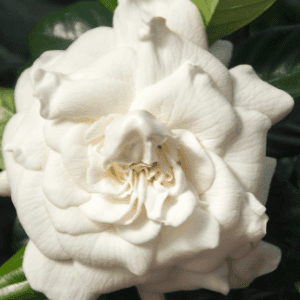
Tropical Lagoon
On the left is the languid lagoon area of Fairchild Tropical Botanical Garden in historic Coral Gables (near Miami). It is North America’s most tropical garden. See this fascinatinating list of what’s in bloom every month there. What blooms in July. If you are interested in tropical plants check Fairchild for a detailed list of what blooms in every month of the year. Our garden is one half zone colder than Miami’s and the 12 plants on this list bloom all year for us.
Our Gardenia Trees in July
On the right is a blooming gardenia. We have a row of these along the east side of the house from the front porch to the planting bench. They give us two intense bloom periods between spring and summer; later, we have a lesser but still fragrant few more months of blossoms.
Don’t Let Midsummer’s Rampant Growth Fool You
In summer’s daily rain and heat, everything grows exponentially! We prune to control the size and before next season’s blossoms set. Beauty duels with fungal disease and other problems in our humid environment. This time of year, it’s easy to be a fool in the garden!
More Midsummer Dreams in July
Don’t you love the comparison of Shakespeare’s characters and us gardeners? The characters are fools because they try to control fate! But does that stop us…?
“Methought I was enamored of an ass”
Titania
_A Midsummer Night’s Dream
12 Great Plants that Bloom All Year
One of Florida’s unique advantages is the good number of plants that bloom throughout the year. They make life brighter and easier in the garden. Such plants provide a background to the exciting problem of always having something of interest every month. Good plants in good places can prevent us from being fools in the garden!
Depending on where you are in Florida, the flowers on this list will bloom for you all year if you are in the hardiness zone for the plant. Many of these plants will offer long seasonal blooming times for your garden in temperate climates. I will note plants that can come indoors for colder winters. The list of names begins with a botanical (Latin) character followed by a common name and is alphabetized by a common name. If I think a name is hard to pronounce, I have added a little help.
Why is the second name in a botanical name not capitalized? The first name is the Genus, (the general category) in italics and capitalized. The second name if used, shows us the species (its more specific) always in italics but lower case so you know if you are looking at a Genus or a species!
Read this to know a little more: It’s a summary of a presentation I give to gardeners in my area.
How to Find Your USDA Plant Hardiness Zone
This is the USDA Plant Hardiness Zone Map. Use it to compare your garden with the hardiness zone of the plant you are interested in. Just put in your zip code; it can save you expense and annoyance!
12 Plants to Bloom all Year
Begonia

Name: Begonia-Begonia
(If the plant name is italicized you are reading the Botanical name. In regular type is the common name.)
Hardiness Zone: 9-11
Begonia Grandis is a hardy plant native to China and will thrive in zones 6-7.
Light Conditions: Part sun for most. A few prefer full sun; check varieties.
Size: Most range from 8″ to 3′ tall, check varieties, with over 2000 species there is plenty of choice.
The Begonia is a genus of over 2000 species of plants that bloom in partial sunlight. In our climate (zone 10a.) the annual varieties can last for several years without a freeze in the garden. For more information try this: “Tuberous Begonia” This is the perennial plant and “Wax Begonia” is the annual which can live indoors for you in the winter.
Blue Daze

Name: Evolvulua glomeratus, Blue Daze (ee-VOL-view-lus-glaw-mer-AH-tuss)
Hardiness Zone: 8a-11a.
Light Conditions: 6 hours or more.
Size: 6′-18″ T & 2′-3′ W
Blue Daze, also called Dwarf Morning Glory, is a nonvining herbaceous perennial commonly used as a ground cover or container plant. You can take cuttings to use indoors and return outdoors in a cool climate. In our garden, near a forest, we use it in containers as the rabbits love it! Any container taller than a rabbit works!
Bougainvillea
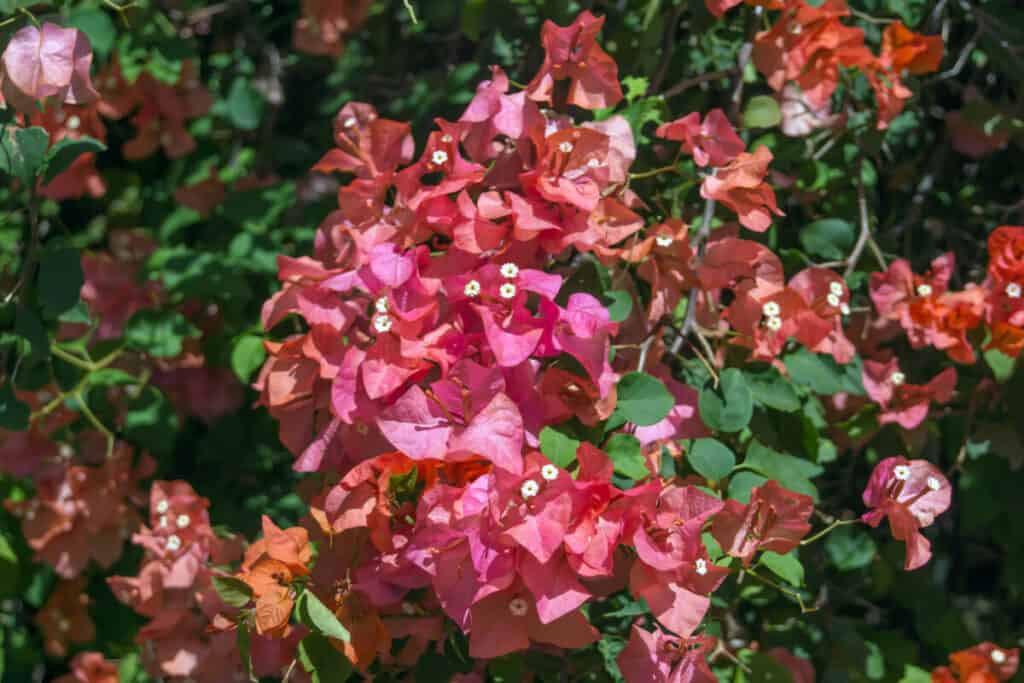
Name: Bougainvillea-Bougainvilllea
Hardiness Zone: 9-11
Light Conditions: Full Sun
Size: 3′-40′ check varieties
Native to eastern South America, bougainvillea is a genus of thorny ornamental vines that say life in the tropics to many of us transplanted northerners. Dwarf varieties stay under 3,’ but some can reach nearly 40′!
For ideas using vines try: “Making an Entrance With Vines”
Firespike

Name: Odontonema strictum, Firespike Plant
Hardiness Zone: 8 or warmer
Light Conditions: Full Sun
Size: 4′-6′
Firespike will bring you hummingbirds and do so with little care. Sitting out in the early evening, we appreciate that the tiny birds stay around to drink the nectar. Native to tropical climates, it thrives in heat and sun. The plant will be healthy in part shade but with far fewer of the big, beautiful floral spikes.
Hibiscus

Name: Hibiscus-Hibiscus
Hardiness Zone: 10-12
Light Conditions: Full Sun
Size: Range from 3-6′ tall
This beauty is a specialty double blooming hibiscus we grow in our front garden to entertain the neighbors. Note the pink center inside the ruffles. The blooms only last for a day, but there are many. If you are in zone 5-9, the temperate hibiscus (Rose of Sharon) will also give you the tropical flair in your yard!
We like to give business to dedicated specialty growers. This is one of three plants we bought from a family grower in Fort Lauderdale. It came packed with tender loving care. It is fun for gardeners to seek out kindred souls and grow their creations in our gardens. Try it!
For true tropical Hibiscus read: “Tropical Hibiscus”
For the Hibiscus look in a temperate climate, read: “Rose of Sharon” in Flowering Trees.
Ixora

Name: Ixora coccinnea-Ixora
Hardiness Zone: 9-11
Light Conditions: best in Full Sun
Size: The standard can reach 10′-15’H which, due to common trimming practice is rarely seen.
The dwarf Variety Ixora taiwanensis reaches 2′.
A member of the same family as coffee, gardenias, and pentas (quite a range), Ixora is a staple of the central and south Florida garden. Every flower cluster lasts 6-8 weeks, and the plant will easily bloom for you all year. It will flower as a specimen or hedge in red, orange, yellow, white, and an ice cream-like tangerine. (Put that with blue.) Ixora loves everything about south Florida life except our alkalinity.
Look for a chlorotic appearance caused by iron and manganese deficiencies or the purple spots on mature leaves that indicate a lack of potassium or phosphorus and treat accordingly. This extroadinarily easy to grow shrub loves everything about our south Florida environment except for our alkaline soil. A minor ammendment works wonders.
Lantana

Name: Lantana-lantana
Hardiness Zone: 9-11, annual in cooler climates.
Light Conditions: Full Sun
Size: 3′-6′ T and 3′-10′ wide when grown as a perennial.
Heat, salt, and drought tolerance makes Lantana one of the most popular flowers in its hardiness zones. The most common is Lantana camera. Not native to Florida it has become invasive in our climate and there are now sterile varieties you can use. There are native varieties in Florida but harder to find and less flashy.
Mexican Heather

Name: Cuphea hyssopifolia -Mexican Heather. False Heather
Hardiness Zone: 9-11
Light Conditions: Full to Part Sun
Size: 1′-2′ T. to 3′ W.
Native to Mexico, Guatamala and Honduras this groundcover or low shrub handles our heat and humidity with aplomb. It has tiny leaves and flowers. It will flower all year in pink, lavender and white.
Pentas

Name: Pentas lanceolata -Penta
Hardiness Zone: 8- 9-11
Light Conditions: Sun to Part Sun
Size: 3′-4′, there is a dwarf variety that will reach 14.”
The dense clusters of tubular star shaped flowers are appealing to hummingbirds and butterflies. There is a dwarf variety that reaches a maximum of 14.” The plant will last more than one year in our climate and somewhat longer in central Florida where we formerly gardened. Cut to the ground and mulched over, they will regrow after winter in zone 8.
Plumbago

Name: Plumbago auriculata-Blue Plumbago
Hardiness Zone: 9b-11
Light Conditions: Full Sun
Size: Can reach 6′-10′ H & W. we customarily see it pruned.
Where do they get the names? This one is a dilly! It comes from the Latin for “looks like lead.” The ancient Roman naturalist Pliny the Elder named it because he thought the blue, phlox-like flowers reminded him of lead, and we still use the name. The plant is both mounding and slightly vining at the same time. In most of Florida you will have blooms all year. In north Florida you will see winter die back with a return in spring.
Salvia
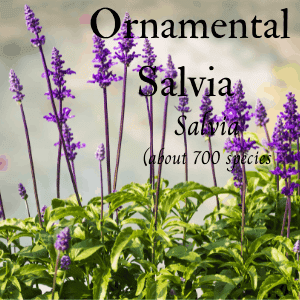
Name: Salvia-Salvia
Hardiness Zone: 5-10
Light Conditions: Full Sun
Size: 18″ to 5′ (check the variety)
Salvia produces not only continuous blooms but in many colors and a reasonable choice of sizes. You can pick the color and layout of your garden, and salvia will likely fill your spot. Note that salvia is one of those plants (like bougainvillea) where we use the botanical name as the common name. How nice!
Vinca
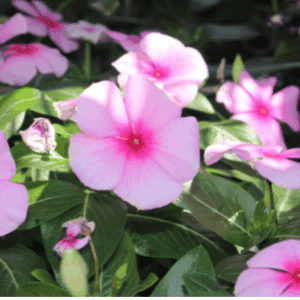
Name: Catharanthus roseus-Annual Vinca
Hardiness Zone: 7-9
Light Conditions: Full Sun
Size: 6″-18″ H and W.
This plant is the annual vinca and like many plants we call “annual” they are really tropical perennials. Consider it as a sort of sunny version of impatiens, they are floriferous, (I love that word= lots of flowers) with a wide variety of color,s and unlike impatiens you can find them with center dots of different colors.
This summer, they are our plant of choice for our community-wide annual beds that welcome residents’ homes and visitors in. Sturdy, colorful, and cost effective.
What’s in Bloom-What to Plant-What to Do
What’s In Bloom In July
Now is the time for the tropical blooms to glow! Some of these plants can be grown as summer annuals or taken indoors for the winter in colder climates. These are discussions of two plants you can use in cool temperatures. The first is Tropical Hibiscus, and the second is large-leafed Elephant Ears. In the case of the HIbiscus, you can plant it in a container that can come indoors. The Elephant Ears can go indoors, or you can cut it back and bring the bulb inside to replant next spring.
Calliandra haematocephala-The Powder Puff!

This powder puff is beloved of bees. It sits in our front lawn providing entertainment as we have morning coffee on our shady porch. The bees come in high volume and (we think they are on leave from a honey grower a few streets away.) If so they should be producing prodigous amounts of honey!
There is a large version but what we grow in a small bed is a dwarf version just the right size for our space.
They’ll grow in full to part sun, blooming best in full sun. The plant is evergreen and will provide both blooms and amusement throughout the year. (Better than Netflix, and I am sure cheaper!) It does bloom for us all year also.
The Herb Garden
Cooking goes on all year, and we grow all the herbs that will survive our hot and wet environment. We find that using containers helps us out because we can move them to shelter from the heavy rains and sun.
Our best performing summer herbs are rosemary, oregano, mint, chives, and basil. Basil in the summer can be challenging, and we keep a continuous set of cuttings to add to summer meals. Even mint, famous for its aggression, falters but always returns. We keep it in pots and plant a variety. (This is, after all the south, and iced tea is an essential food group!)
Pruning Your Herbs in Mid Summer

Especially in summer’s rampant growth, it is vital to prune regularly. This helps provide flavor in the kitchen and healthy plants.
What to Plant in July
In our warm climate, try these choices below. Our state university extension service and our own experience recommend these plants. Other ways to find suitable plants for your locale and time of year are to check your nearest public garden and the best local garden centers.
What to Do in July
Weeding, weeding, and more weeding; as soon as I leave these keys, I will be weeding. We have heavy rains as well as sun. The weeds get bigger before our eyes.
What To Do In October
| Plants | Names | References |
| Annuals | Salvia, coleus, torenia, celosia, vinca | https://gardeningsolutions.ifas.ufl.edu/plants/ornamentals/annual-flowers.html |
| Vegetables | Warm season varieties | http://edis.ifas.ufl.edu/pdffiles/vh/vh02100.pdf |
| Herbs | Many herbs | https://gardeningsolutions.ifas.ufl.edu/plants/edibles/vegetables/herbs.html |
| bulbs | Gladiolus, butterfly lily | |
| Palms | Summer is a good time to plant palms, brace the taller ones for6-8 months | https://gardeningsolutions.ifas.ufl.edu/care/planting/planting-palms.html |
What to Do in July
| Category | What To Do | Reference |
| Trees | Prune in preparation for hurricane | https://gardeningsolutions.ifas.ufl.edu/plants/trees-and-shrubs/trees/preparing-trees-for-hurricanes.html#: |
| Irrigation | Install shutoff in rainy season | |
| Lawn | Identify the source of problems before treating | https://www.scotts.com/en-us/library/lawn-disease-control/how-identify-lawn-diseases |
| Pests | check ornamental plants for pests | https://ipm.ifas.ufl.edu/Agricultural_IPM/Ornamentals.shtml |
Update On A Midsummer Project
During Covid’s intense boredom, we created a new garden seating area. (How much sourdough bread can you eat?)The new space would provide a spot to enjoy excellent winter evenings. We have planted the littoral shelf area along the pond edge and it seems to attract the wading birds, making the site an attractive place to linger.
Since moving in about six years ago trees we added are producing some shade which prompted changing some turf areas to groundcover and stepping stones. Here is the initial discussion of the project goals and the small obstacles we needed to overcome.
The Marsh Rabbits
We have a lot of rabbits. They are marsh rabbits, a subset of the cottontail, and not the prettiest of the bunch. They have smaller ears and beady eyes. They do however have their own charms, and we like to have coffee outside and watch them. They covet the hibiscus blossoms that drop at night near our front porch. The little creatures are fussy though, and prefer those that are dry and not soggy from rain or the irrigation system. They will stand on their hind legs and pull down their favorite low growing blossoms.
Rabbits are voracious eaters and some of our favorite herbacious plants are theirs also!
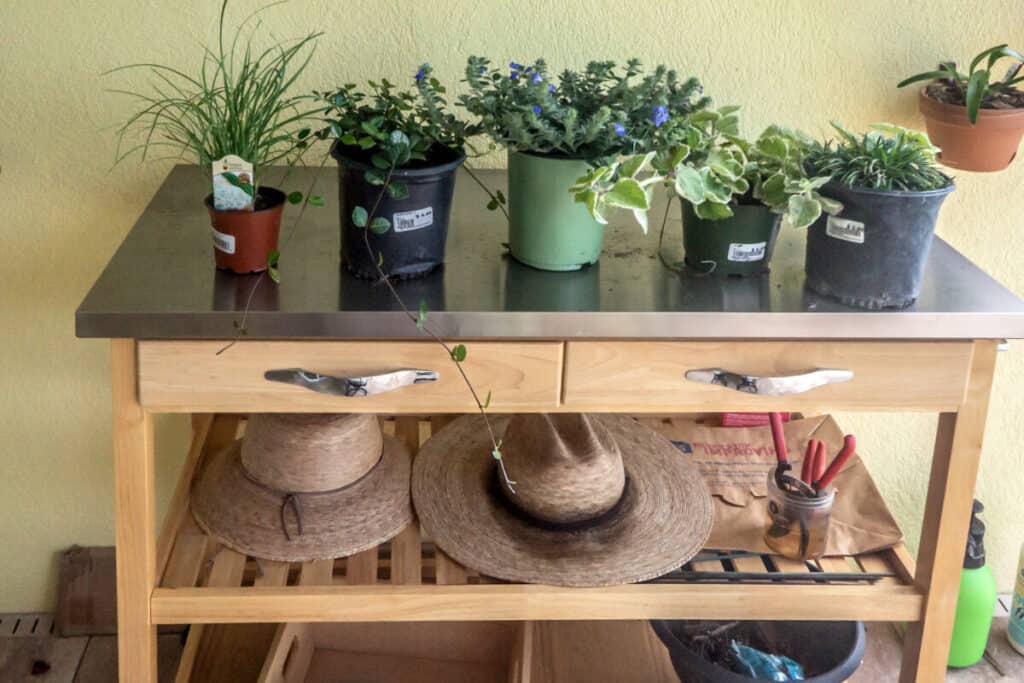
These are ground covering plant samples that we have tested. Rabbits do not like any strong scented foliage. Some samples are the ground covers themselves. others are aromatic herbs that seem to dissuade the rabbits.
The Project Status So Far
The project aims to surround the seating area with a low-growing ground cover. We tried all of the plants in the photo above. Our best performer was the low-growing dwarf mondo grass. It is beautiful surrounding the silvery stepping stones; it’s resilient when walked over, and the rabbits like it least.
What Plants Do The Rabbits Hate?
Predation by rabbits and deer is a constant problem in our garden on the edge of a state forest. We all try various cures many of which the animals consider tasty hors d’oeuvres. Our garden is about 10 minutes from a large public garden. We try the same remedies, and appear to have about the same results. Our best winner, however, is Cuban Oregano, a pretty, variegated herb which is also has a misleading name, being neither Cuban nor Oregano! Still, it is powerfully aromatic, and the rabbits who nest nearby, avoid it like the plague! They also dislike mint and chive plants.
Our wildlife camera took nighttime photos of deer so we know they are grazing in the backyard. They also do not appreciate the strong scents and their hoofmarks and photos are beyond the new planted area. You can never be certain about wildlife, true hunger changes the rules. But, so far so good with wildlife.
Try Cuban Oregano, it’s pretty, useful in the kitchen and you can bring it indoors for the winter.
Hurricane Preparation
Hurricane preparation, in a climate with real hurricanes, is an all year process. We plant trees in groups, we select hurricane resistant varieties. This link will take you to a variety of research items from the University of FLorids regarding hurricane resistant trees. The University of Florida is a major center for hurricane research in the U.S.
” Hurricane Proof Your Florida Yard and Garden,” reflects what we have learned to keep our own garden safe.
July’s Summary-Long Blooming Gardens
“The Course of true love never did run smooth”
-The character Lysander in Shakespeare’s ” A Midsummer Nights Dream”
I like this quote. It’s yet another example of how gardeners live at the intersection of art and nature, isn’t it! Shakespeare, a man who loved his gardens, compares love to the vagaries of a river. We live on a water body; the water is either not enough or covering the plants!
Shakespeare the Gardener

Here is a performance in Shakespeare’s garden. We were impressed that the actors were so confident that they took requests. They slipped easily into any role the crowd asked for.
The various houses in Stratford upon Avon related to Wil have beautifully maintained gardens in the style that Shakespeare might have known. They are well worth a visit.
Here is a little more information on visiting Shakespeare’s hometown.
Shakespeare’s Midsummer Night’s Garden
What goes on in July, one of our most humid months in the garden is a good example. We like this summer life, early mornings for horticulture, afternoons in the pool at the garden edge and evenings watching the wildlife feed and sitting in the green space that covid boredom induced us to make.
The Value of Long Blooming Flowers
One of the most exciting challenges of gardening is not makeing something interesting part of the time but keeping the garden interesting all year round. I just finished reading an article on how the shapes of evergreen topiaries made the snowy winter garden beautiful.
That’s the kind of thinking that keeps a garden beautiful. And one of the easiest ways to add constant interest is to use long blooming flowers. These 12 plants create extroadinarily long bloom times.
How do you make your garden interesting all year round?
Use the link below to contact me and tell me what you rely on for color throughout your season?
